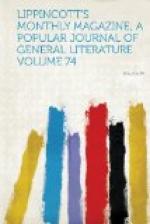Northward from the Acropolis, on a slight elevation, is the best-preserved and one of the most ancient structures of Athens—the temple of Theseus, built under the administration of Cimon by the generation preceding Pericles and the Parthenon. It is of the Doric order, and shaped like the Parthenon, but considerably inferior to it in size as well as in execution. It has been roofed with wood in modern times, and was long used as a church, but is now a place of deposit for the numerous statues and sculptured stones of various kinds—mostly sepulchral monuments—which have been recently discovered in and about the city. They are for the most part unimportant as works of art, though many are interesting from their antiquity or historic associations. Among these is the stone which once crowned the burial-mound on the plain of Marathon. It bears a single figure, said to represent the messenger who brought the tidings of victory to his countrymen.
Near the Theseium was the double gate (Dipylum) in the ancient wall of the city whence issued the Sacred Way leading to Eleusis, and bordered, like the Appian Way at Rome, with tombs, many of them cenotaphs of persons who died in the public service and were deemed worthy of a monument in the public burying-ground. Within a few years an excavation has been made through an artificial mound of ashes, pottery and other refuse emptied out of the city, and a section of a few rods of this celebrated road has been laid bare. The sepulchral monuments are ranged on one side rather thickly, and crowd somewhat closely upon the narrow pavement. They are, for the most part, simple, thick slabs of white marble, with a triangular or pediment-shaped top, beneath which is sculptured in low relief the closing scene of the person commemorated, followed by a short inscription. The work is done in an artistic style worthy of the publicity its location gave it. On one of these slabs you recognize the familiar full-length figure of Demosthenes, standing with two companions and clasping in a parting grasp the hand of a woman, who is reclining upon her deathbed. The inscription is, Collyrion, wife of Agathon. On another stone of larger size is a more imposing piece of sculpture. A horseman fully armed is thrusting his spear into the body of his fallen foe—a hoplite. The inscription relates that the unhappy foot-soldier fell at Corinth by reason of those five words of his!—a record intelligible enough, doubtless, to his contemporaries, but sufficiently obscure and provocative of curiosity to later generations.
There are other noted structures at Athens, such as the Choragic Monument of Lysicrates—the highest type of the Corinthian order of architecture, as the Erechtheum is of the Ionic and the Parthenon of the Doric—but want of space forbids any further description of them. Let the American traveler visit Athens with the expectation of finding a city occupying the most charming of sites, and containing by far the most interesting and important monuments of antiquity, in their original position, to be found in the whole world.




